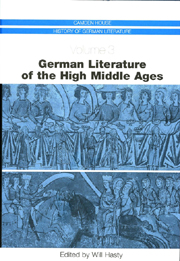Book contents
- Frontmatter
- Contents
- List of Illustrations
- Acknowledgments
- Introduction
- Part I The First Flourishing of German Literature
- Part II Lyric and Narrative Traditions
- Didactic Poetry
- Minnesang — The Medieval German Love Lyrics
- The German Heroic Narratives
- Early Mystical Writings
- Part III Continuity, Transformation, and Innovation in the Thirteenth Century
- Part IV Historical Perspectives
- Bibliography
- Notes on the Contributors
- Index
Early Mystical Writings
from Part II - Lyric and Narrative Traditions
Published online by Cambridge University Press: 05 February 2013
- Frontmatter
- Contents
- List of Illustrations
- Acknowledgments
- Introduction
- Part I The First Flourishing of German Literature
- Part II Lyric and Narrative Traditions
- Didactic Poetry
- Minnesang — The Medieval German Love Lyrics
- The German Heroic Narratives
- Early Mystical Writings
- Part III Continuity, Transformation, and Innovation in the Thirteenth Century
- Part IV Historical Perspectives
- Bibliography
- Notes on the Contributors
- Index
Summary
THE FLOWERING OF MEDIEVAL GERMAN LITERATURE that began in the decades around 1200 was not limited to the secular courts. Beginning in the early thirteenth century, changing currents in Christian religious thought and practice led to a notable increase in the production and consumption of religious writing in the vernacular. The rise of new religious orders advocating vernacular preaching facilitated the spread of religious enthusiasm for the pious life both within and outside of religious orders, especially among women. The religious and mystical literature of the German Middle Ages thus differs in one important respect from the secular tradition: it includes a number of significant texts written by women. Another important difference is that although the secular tradition bloomed in the southern German-speaking regions at aristocratic courts, which is reflected in the transmission of that literature in dialects considered to be Middle High German, the mystical tradition emerged initially in central and northern urban settings where Middle Low German and Middle Dutch were spoken. Hence, this essay considers not only the now canonical Das fliessende Licht der Gottheit (The Flowing Light of the Godhead) a 1345 translation (by Heinrich von Nördlingen) into Middle High German of Mechthild von Magdeburg's now lost Middle Low German original, which she wrote between 1250 and 1282, but also the writings of two of her predecessors who wrote in Middle Dutch: Beatrijs (Beatrice) van Nazareth's Seven manieren van minne (Seven Manners of Love, written around 1250), and Hadewijch's visions, letters, and poems (written around 1240).
- Type
- Chapter
- Information
- German Literature of the High Middle Ages , pp. 185 - 200Publisher: Boydell & BrewerPrint publication year: 2006



